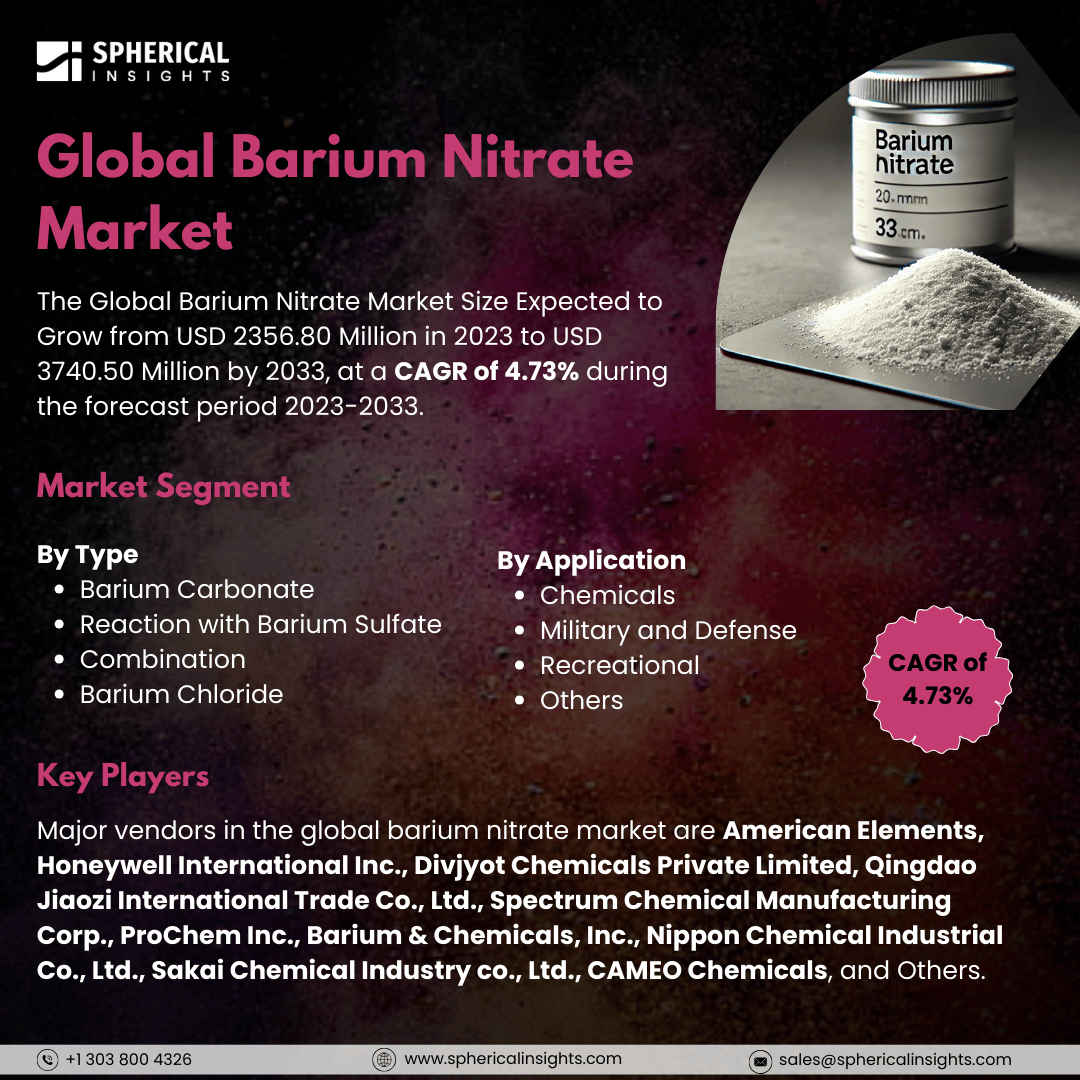Global Barium Nitrate Market Size to Exceed USD 3740.50 Million by 2033
According to a research report published by Spherical Insights & Consulting, The Global Barium Nitrate Market Size Expected to Grow from USD 2356.80 Million in 2023 to USD 3740.50 Million by 2033, at a CAGR of 4.73% during the forecast period 2023-2033.
Browse 210 market data Tables and 45 Figures spread through 190 Pages and in-depth TOC on the Global Barium Nitrate Market Size, Share, and COVID-19 Impact Analysis, By Type (Barium Carbonate, Reaction with Barium Sulfate, and Combination with Barium Chloride), By Application (Chemicals, Military and Defense, Recreational, and Others), and By Region (North America, Europe, Asia-Pacific, Latin America, Middle East, and Africa), Analysis and Forecast 2023 – 2033
Barium and nitrate ions combine to form the organic salt known as barium nitrate. It has no color or smell and dissolves well in acetone, ethanol, and water. There are two ways to make barium nitrate, a crystalline substance that is found naturally as nitrobarite. Barium nitrate crystals are extracted from the mixture in the first step, which is the reaction of barium carbonate with nitric acid. In the second step, barium chloride and sodium nitrate solution mix to form barium nitrate crystals. Between 500°C and 700°C, the product degrades thermally, generating nitrogen dioxide, barium oxide, and oxygen. Additionally, the rising demand for fireworks and pyrotechnic displays, particularly during festive seasons and festivities around the world, is linked to the growth in the barium nitrate market share during the projection period. The market is also growing as a result of the growing usage of barium nitrate in the production of specialty glasses, such as optical and glass ceramics. However, the market for barium nitrate is constrained by the availability of substitutes. Barium nitrate can be replaced by a wide variety of commercially available substances, which could have an effect on market expansion. Applications for barium nitrate are numerous and include pyrotechnics and explosives.
The barium carbonate segment is expected to hold the largest share of the global barium nitrate market during the projected timeframe.
The global barium nitrate market is segmented by type into barium carbonate, reaction with barium sulfate, and combination with barium chloride. Among these, the barium carbonate segment is expected to hold the largest share of the global barium nitrate market during the projected timeframe. Barium carbonate and nitric acid typically react to generate barium nitrate. The barium nitrate crystals are extracted from the mixture using this process. Because barium carbonate is a frequently available raw material and the production process is very simple, this method is widely employed.
The chemicals segment is expected to grow at the fastest CAGR during the projected timeframe.
Based on the application, the global barium nitrate market is categorized as chemicals, military and defense, recreational, and others. Among these, the chemicals segment is expected to grow at the fastest CAGR during the projected timeframe. A common raw ingredient for the production of many different chemicals, such as paints, ceramic glazes, insecticides, and barium oxide and its derivatives, is barium nitrate. Barium nitrate is the most widely used and dominant segment of the market due to its versatility in these chemical applications as well as growing demand from sectors like glass, ceramics, and specialty chemicals.
Asia-Pacific is projected to hold the largest share of the global barium nitrate market over the forecast period.
Asia-Pacific is projected to hold the largest share of the global barium nitrate market over the forecast period. This is due to pyrotechnics' and industrial applications' strong growth. Production of barium nitrate increased by 15% in 2023 compared to 2022, according to China's Ministry of Industry and Information Technology. In 2024, the ceramic industry's use of barium nitrate rose by 20%, according to the Indian Ministry of Chemicals and Fertilizers. In 2023, barium nitrate used to make fireworks increased by 12% in Japan, according to the Japan Pyrotechnics Association. The Ministry of Trade, Industry, and Energy of South Korea forecasted an 18% growth in barium nitrate-based product exports in 2024.
North America is expected to grow at the fastest CAGR growth of the global barium nitrate market during the forecast period. The United States Geological Survey projects that domestic barium nitrate use will increase by 8% in 2023, mostly as a result of expansion in the aerospace and defense sectors. In 2024, professional fireworks displays used 10% more barium nitrate, according to the American Pyrotechnics Association. In 2023, barium nitrate imports for the oil and gas sector increased by 7%, according to Natural Resources Canada. By 2024, barium nitrate use for military pyrotechnics and tracer ammunition is expected to increase by 15%, according to the US Department of Defense.
Company Profiling
Major vendors in the global barium nitrate market are American Elements, Honeywell International Inc., Divjyot Chemicals Private Limited, Qingdao Jiaozi International Trade Co., Ltd., Spectrum Chemical Manufacturing Corp., ProChem Inc., Barium & Chemicals, Inc., Nippon Chemical Industrial Co., Ltd., Sakai Chemical Industry co., Ltd., CAMEO Chemicals, and Others.
Key Target Audience
- Market Players
- Investors
- End-users
- Government Authorities
- Consulting and Research Firm
- Venture capitalists
- Value-Added Resellers (VARs)
Market Segment
This study forecasts revenue at global, regional, and country levels from 2020 to 2033. Spherical Insights has segmented the global barium nitrate market based on the below-mentioned segments:
Global Barium Nitrate Market, By Type
- Barium Carbonate
- Reaction with Barium Sulfate
- Combination
- Barium Chloride
Global Barium Nitrate Market, By Application
- Chemicals
- Military and Defense
- Recreational
- Others
Global Barium Nitrate Market, By Regional
- North America
- Europe
- Germany
- UK
- France
- Italy
- Spain
- Russia
- Rest of Europe
- Asia Pacific
- China
- Japan
- India
- South Korea
- Australia
- Rest of Asia Pacific
- South America
- Brazil
- Argentina
- Rest of South America
- Middle East & Africa
- UAE
- Saudi Arabia
- Qatar
- South Africa
- Rest of the Middle East & Africa



